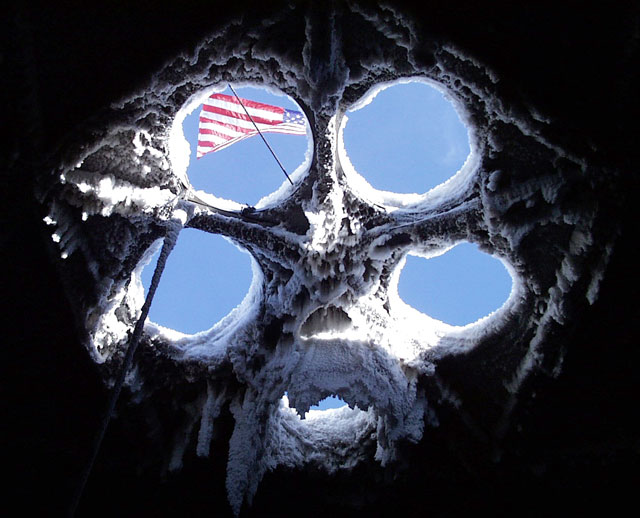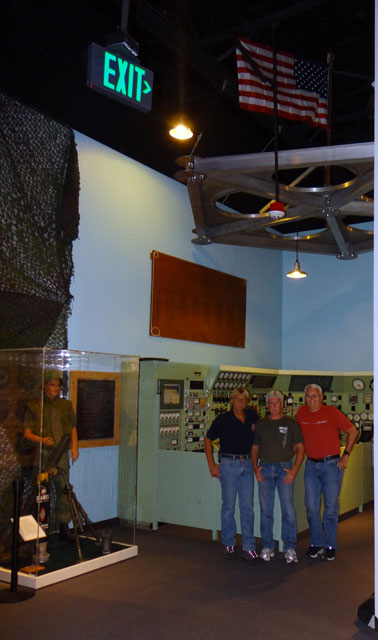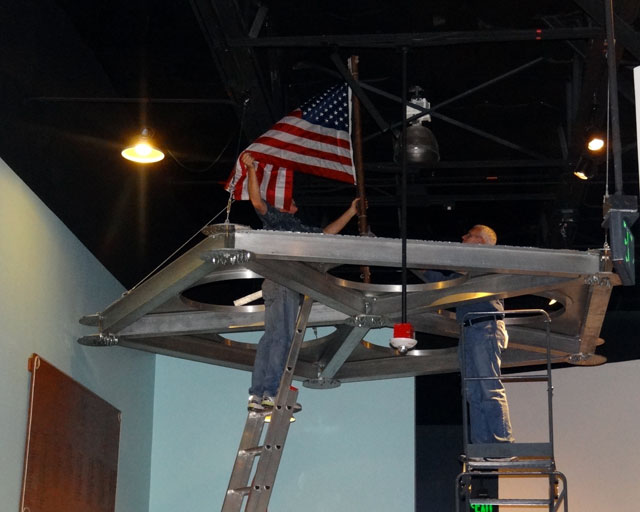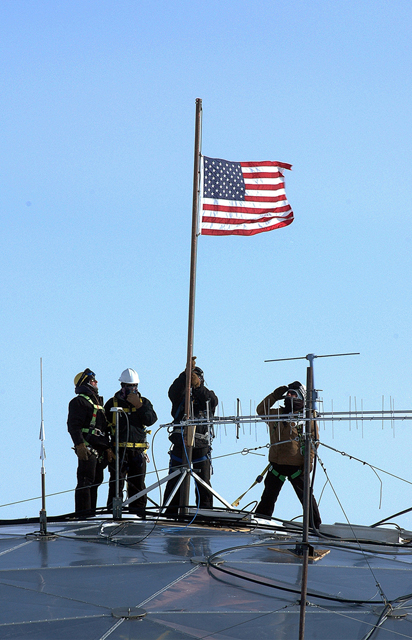|
Finishing the jobPolies crown South Pole dome in Seabee museum with Old GloryPosted May 18, 2012
Polies don’t leave a job undone. Last summer, a few Antarctic veterans literally raised the roof on an exhibit at the newly opened Seabee Museum But one thing was missing — the iconic American flag that could be glimpsed through the vent holes by those walking under the dome for all those years. Now the exhibit is complete. “We knew we were part of something very special. It was an honor to be responsible for handling history, making sure the U.S. flag placement was done right, and would reflect for visitors how it really looked when you looked up through the vent holes,” said Jerry Marty, who had been at the South Pole in the 1970s while the dome was under construction. He later oversaw construction of the newest South Pole research station for the National Science Foundation (NSF) 
Photo Credit: Josh Landis/Antarctic Photo Library
An American flag seen through one of the vent holes of the dome at the South Pole.
By then, the buildings under the old dome had been removed. The geodesic structure was being used as a temporary cold storage warehouse. Two years later, it was deconstructed, carefully packaged, and sent north to Port Hueneme, where the NSF has warehouse facilities for the U.S. Antarctic Program (USAP) In July 2011, Marty, Lee Mattis and John Perry pulled up their sleeves and dug through the crates to find the top ring of the dome. In two days, they had reassembled it and hung it from the ceiling of a new 38,000-square-foot museum dedicated to the U.S. Naval Construction Battalion Mattis was the civilian project engineer who designed the specialized erection equipment and the scheme of how to assemble the geodesic dome on ice. He spent two summer seasons at the South Pole between 1971 and 1973. Perry was the naval officer in charge of construction those two Antarctic summers. Several active-duty Seabees, as well as a retired Navy master chief, helped with transporting, assembling and lifting the 600-pound crown of the dome into place on July 14, 2011. This time around, the trio had also recruited the help of Steve Bruce, who was the project manager for the dome deconstruction during the 2009-10 summer at South Pole. He deflected any credit for the successful and quick completion of the project. “The fact that we were able to get the dome down safely, completely and sent home that season was only possible due to the buy-in and tremendous input and teamwork from so many folks,” Bruce said. “I wouldn’t have had a starting point were it not for Jerry, Lee and John. … It was one of my most enjoyable seasons ever.” After an intensive search of the Port Hueneme cargo storage areas, the men located the crate where the original flagpole had been boxed up. “This took a lot more time than we had planned, and we almost gave up and we were considering an alternative of using a piece of galvanized pipe if the original pole could not be found,” Marty said. “We were running out of time as we only had one day to complete the project.” 
Photo Courtesy: Jerry Marty
Jerry Marty, Steve Bruce and Lee Mattis pose under the finished South Pole dome exhibit at the Seabee Museum.
Fortunately, Bruce spotted the correct box as the men followed the paperwork trail around the warehouse. “We had to shorten its original length in order to fit between the top dome ring and the ceiling of the Seabee museum,” said Bruce, who had wintered at the South Pole under the dome in 1993. Mattis noted that the flagpole assembly also included the three original angled metal brackets that braced the copper flagpole to the dome structure. The men bolted the brackets to the dome at the same locations in the original drilled holes and fastened them to the flagpole with self-drilling screws. “Steve Bruce was our leader, directing the operation and coming up with a clever restraint at the flagpole base to hold it in place,” Mattis said. “Given Steve’s significant efforts in disassembling and saving the Dome, it was most appropriate for him to participate and have this role.” Marty had already been thinking ahead to this day. “As we were nearing the completion of the new station construction and approaching my retirement, I realized that should the dome deconstruction allow for any portion to be returned for display, it would not be complete without a U.S. flag,” he said. He purchased an American flag and flew it at the geographic South Pole in December 2008. It was returned to its rightful place on March 29, 2012, at 2:41 pm Pacific Time. “Placing the flagpole and flag on top of the display really brings closure to our efforts to save the dome section and makes a fitting display [for] the Seabee efforts in Antarctica,” Perry said. |



For USAP Participants |
For The Public |
For Researchers and EducatorsContact UsU.S. National Science FoundationOffice of Polar Programs Geosciences Directorate 2415 Eisenhower Avenue, Suite W7100 Alexandria, VA 22314 Sign up for the NSF Office of Polar Programs newsletter and events. Feedback Form |



